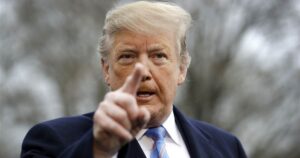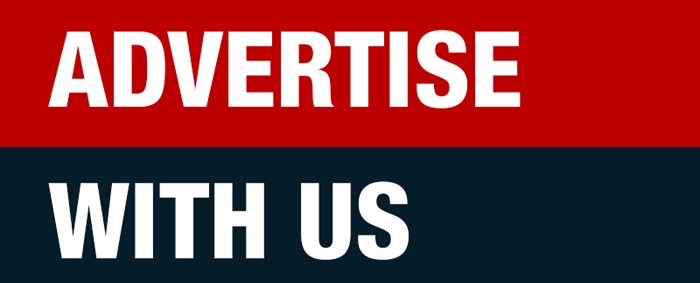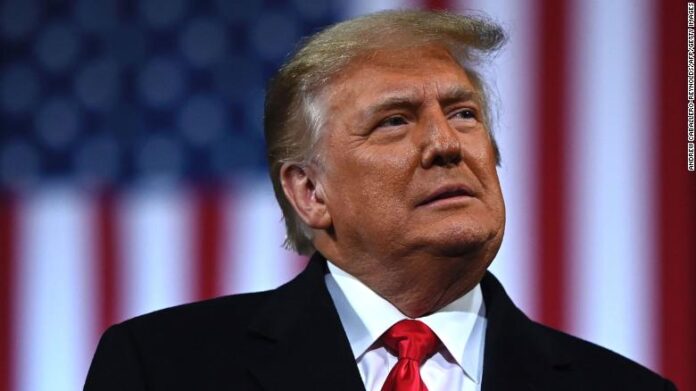He told one adviser during an expletive-laden conversation recently never to bring up the ex-president ever again. During the passing mention of resigning this week, Trump told people he couldn’t count on Vice President Mike Pence to pardon him like Gerald Ford did Nixon, anyway.
Eager for a final taste of the pomp of being president, Trump has asked for a major send-off on Inauguration Day next week, according to people familiar with the matter, before one last presidential flight to Palm Beach.
But the signs of his impending departure are everywhere — including right outside his window. Workers hung bunting Thursday that read “2021 Biden-Harris Inauguration” from temporary stands across from the White House North Portico. It was visible from his third-story residence.
Inside the building, Trump has been weathering a second impeachment and growing isolation from his onetime allies in sullen desolation. He has grown more and more worried about what legal or financial calamities may await him when he is no longer president, people who have spoken to him said, fueled by warnings from lawyers and advisers. He is weighing pardons, including for himself and his family, as he attempts to muster a legal team for another impeachment trial. And he is resentful of Republicans who he feels abandoned him in his hour of need, including the GOP leaders of the House and Senate.
Aides have pleaded with Trump to deliver some type of farewell address, either live or taped, that would tick through his accomplishments in office. But he has appeared disinterested and noncommittal. On Thursday, it was Pence carrying out tasks ordinarily left to a president, like visiting national guardsmen posted at the US Capitol or visiting White House operators to say farewell.
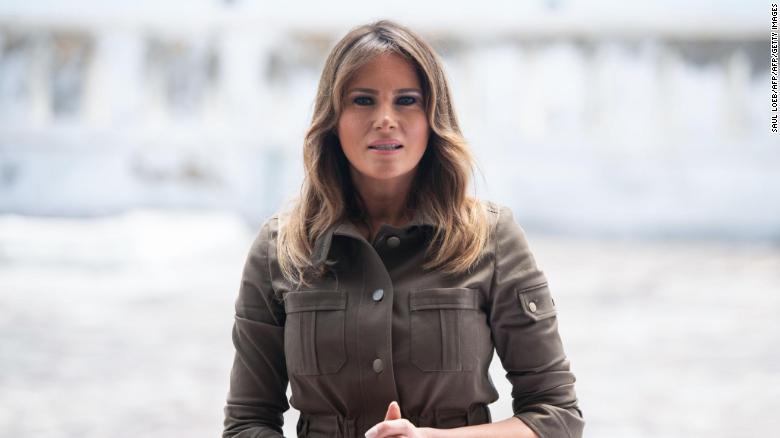
Silent Melania Trump plods toward end of her husband’s tumultuous term
With less than a week left in office, Trump’s staff is preparing to leave the White House campus for a final time. Many officials have already departed, but those who are still coming into the office have focused on the offboarding process and packing up their offices. There were signs of moving activity Thursday, including a gray van from the fine art movers Crozier. Debbie Meadows, the wife of the chief of staff, was spotted carrying out a stuffed pheasant from her husband’s office and loading it into her car.
The upstairs of the White House press shop now sits virtually empty. Desks where assistants used to sit outside the office of the press secretary are now vacant, with the exception of boxes and stacks of documents. Press secretary Kayleigh McEnany, who has been largely invisible during the final days of the Trump White House, has also started packing up her office.
One of Trump’s Cabinet officials, Commerce Secretary Wilbur Ross, appeared on television from Palm Beach. Another official, National Economic Council director Larry Kudlow, received applause from junior aides as he left the building.
As one of their final acts, Trump’s team is working to organize a crowd to see him off on the morning of Biden’s inauguration, when he plans to depart Washington while still president and is expecting a major send-off. Even though some of his allies had encouraged him to attend Biden’s inauguration, and Trump quizzed his circle on whether he should, few ever expected him to participate in the swearing-in of his successor.
Trump told people he did not like the idea of departing Washington for a final time as an ex-president, flying aboard an airplane no longer known as Air Force One. He also did not particularly like the thought of requesting the use of the plane from Biden, according to a person familiar with the matter.
For now, Trump is undecided on whether he will pen a letter to Biden to leave in the Resolute Desk in the Oval Office. Some of his advisers have encouraged him to think about continuing the tradition. Early in his presidency, Trump liked to show off to visitors the letter he received from President Barrack Obama, which included the now-prescient line: “Regardless of the push and pull of daily politics, it’s up to us to leave those instruments of our democracy at least as strong as we found them.”
Initially, Trump had planned to depart the White House a day early. But he now plans to leave on the morning of January 20. His departure aboard Marine One from the White House South Lawn will likely be visible and audible to the Bidens, who will spend the night before the inauguration at Blair House, across Pennsylvania Avenue from the executive mansion. Its use was offered to them by the State Department rather than the Trumps, who refuse to make contact with the incoming president and first lady.
Final plans for Trump’s departure were still being laid a week ahead of time, but Trump has expressed interest to some in a military-style sendoff and a crowd of supporters, according to a person with whom he has discussed the matter. Whether that occurs at the White House, Joint Base Andrews or his final destination — Palm Beach International Airport — wasn’t clear. Trump is expected to be ensconced in his Mar-a-Lago club or his nearby golf course by noon on Inauguration Day, when his term officially ends.
Having the outgoing president 1,000 miles away from the incoming one provides some logistical challenges. For instance, handoff of the nuclear football — a 45-pound briefcase that accompanies the president everywhere he goes in case of nuclear attack — won’t be as simple as it would be if the two men were in each other’s vicinity.
A person familiar with the matter said the White House Military Office will ensure there are multiple nuclear footballs — one to accompany Trump to Florida and one that will be ready in Washington for when Biden officially becomes president. The nuclear codes Trump carries on a card alongside the football — the so-called “biscuit” — would no longer work past noon.
Legal and financial troubles
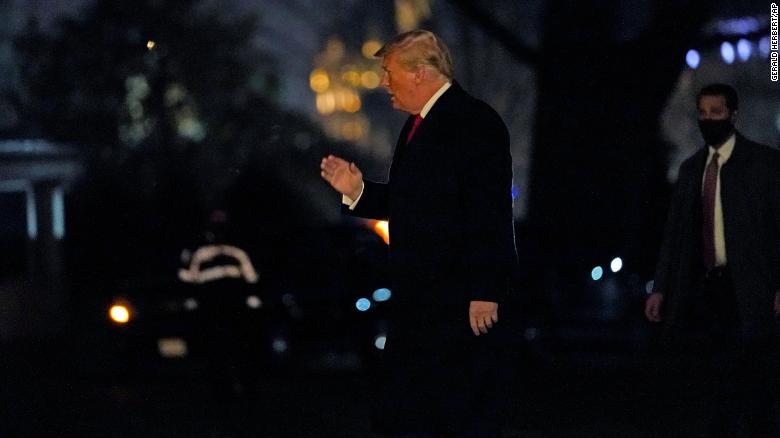
Trump’s actions in last days as President increase his legal jeopardy
Though Trump, in private, still contends he won the 2020 election, he has fully resigned himself to leaving the White House and entering life as a private citizen — and with it the potential legal exposure and business troubles sparked by his role in inciting the riots last week.
The first order of business will be his second impeachment trial, which is now set to begin after Biden is sworn in. Trump is still enlisting lawyers to represent him during the proceedings, and appears to have soured on Rudy Giuliani, whose legal fees he has ordered aides not to pay. A band of Trump associates had worked recently to dissuade the President from listening to Giuliani because they believed he was providing him with misinformation.
Instead, Trump is looking to a new set of attorneys, including potentially John Eastman, the conservative attorney who falsely told Trump that Pence could block the certification of Biden’s win. A person familiar with the matter said Eastman could join Trump’s legal team defending him in the upcoming impeachment trial.
Trump’s senior advisers in the White House have said they don’t believe Senate Majority Leader Mitch McConnell will vote to convict him, but is happy to let the option hang over his head during his final days in the White House, given his deep anger at the President.
According to those around him, Trump has been more focused on potential post-presidency legal woes since well before the November election, and his worry has increased in the months since, people familiar with the matter said.
Yet he has also been lashing out at aides, allies and lawyers trying to protect him from criminal exposure following his role in inciting rioters during last week’s insurrection attempt at the US Capitol. Some of his attorneys have tried to explain that his notion of a self-pardon may not hold up, which has led some inside Trump’s circle to believe he is less likely to attempt it before he leaves office.
Those concerns are partly what helped convince Trump to record a video on Wednesday condemning the riots and insisting they did not reflect his political movement.
“No true supporter of mine could ever endorse political violence. No true supporter of mine could ever disrespect law enforcement or our great American flag,” he said from behind the Resolute Desk in the Oval Office.
Trump had seemed reluctant to tape the video, in part because he believes the carefully denunciations of his supporters make him look like he’s caving to pressure to tone down his stance on the election.
A source familiar with conversations said there was a coordinated full-court press by allies and aides, including Sen. Lindsey Graham, chief of staff Mark Meadows and senior adviser Jared Kushner to convince the President he had to come out forcefully against further violence and that if he didn’t — and another incident happened — he would “own it.”
“Silence is not an option,” the source said in describing one of the conversations. “We need to break the cycle.”
After an ad-libbed video on the day of the insurrection attempt, Trump’s subsequent appearances have been more tightly scripted, with heavy input from the White House counsel’s office on the text. Trump has read them from teleprompters set up by the White House Communications Agency as senior officials look on, ensuring he does not diverge from the words as written.
While Trump has long fretted about his potential legal troubles, it has only been recently that he has weighed anxiously the potential business downsides to his divisive tenure. The decision by the PGA this week to strip his Bedminster, New Jersey, golf course of a championship tournament infuriated the President.
Another discussion that could be hampered by the fallout from the riot he helped stoke is his presidential library. Before Trump’s rabble-rousing speech, there had been talk of securing property in Florida and having Dan Scavino, his longtime aide, run it. But now there are questions about who would donate to Trump’s library in the current climate.
For a man highly attuned to the kind of pomp he believes affirms his elevated position in life, the abrupt removal of the PGA honor came as a blow not only to his bottom line but to his ego. And it provided an unpleasant harbinger of the life he might lead once he leaves office, without the fanfare that accompanied his every move as president.
This week has provided him a preview of sorts. He has remained behind closed doors for most days, with no cameras documenting his moves and no audiences to applaud him as he goes about his day. The circle of obsequious aides that have surrounded him for most of his term is shrinking, replaced by only a few — such as Scavino and personnel chief Johnny McEntee — who will remain with him until he departs the White House.
The President has been discussing his election conspiracy theories with his former chief strategist Steve Bannon — who’s facing federal fraud charges – in recent weeks, a senior Trump adviser confirmed, as he pushes away advisers who tell him what he doesn’t want to hear.
Events that would ordinarily be open to press, such as ceremonies awarding the Medal of Freedom and National Medal of Arts, have been limited to only government cameras.
According to one official, aides worried that Trump might respond off-the-cuff to a question about the riots and veer from the carefully scripted comments condemning the actions. They determined it was better to limit Trump’s opportunities before the media.
